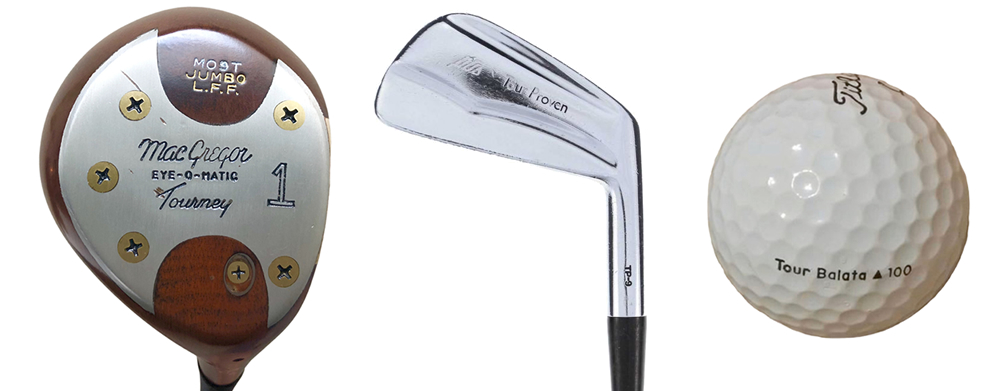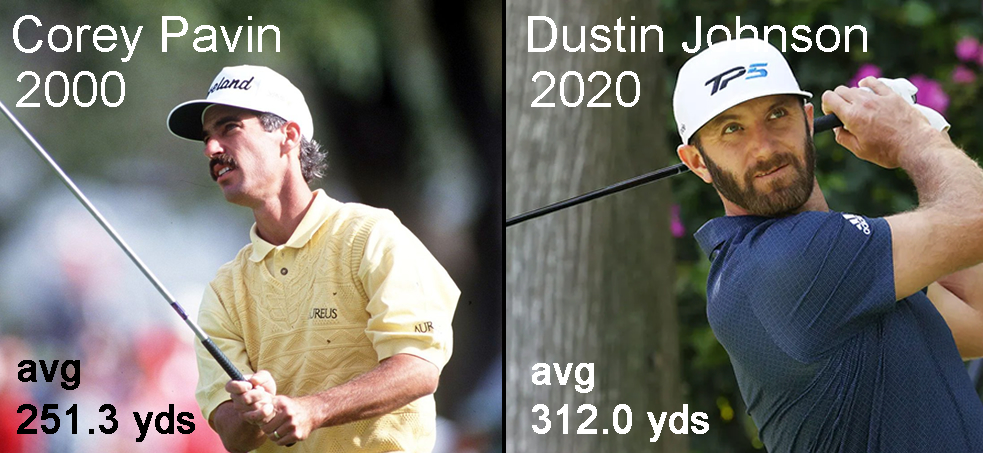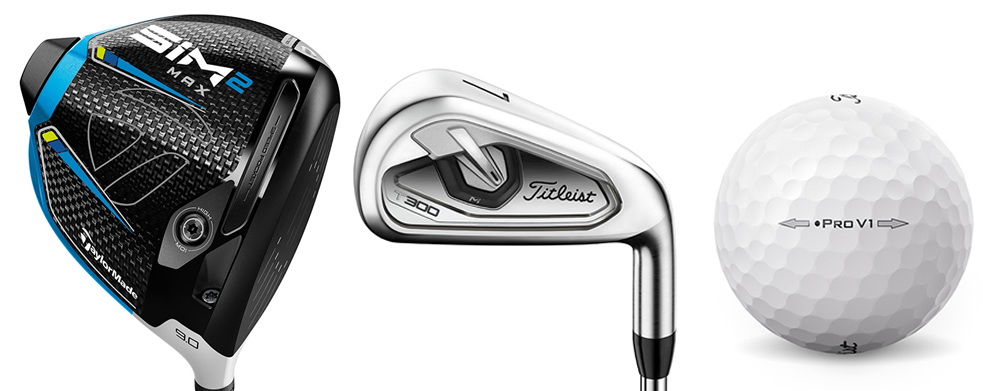How Modern Golf Equipment Has Changed The Game Of Golf
With the pandemic induced golf boom that we are currently experiencing, there are many golfers who are completely new to the game. Most of the new players (and in fact anyone that started playing post 2010) probably don’t realise how much the game of golf has changed over the past twenty years. In this article I’m going to take you on a little journey down memory lane and look and the way things used to be.
I started playing golf in 1985 when my dad took me to the pitch and putt at Heaton Park near Manchester. Back in those days the equipment was vastly different from the technological wonders that grace today’s golf bags. There was no such thing as metal woods, we had to make do with laminate wooden woods, or if you had a few quid, you could get your hands on a persimmon wood which were things of incredible beauty. The feeling at impact when you hit one out of the screws (they actually had screws in the centre of the face – hence the term still said today) was utterly delightful. Unfortunately, shots that were struck from the heel or the toe were significantly less delightful, and the result would usually be reaching for another ball from your bag.
They were also remarkably heavy. Graphite shafts were still some years away, just a faint idea, simmering away in the head of an engineering boffin. We had to make do with steel, but not the lightweight joys found in today's clubs, no, these were cumbersome tubes that really took some swinging. Long hitters were few and far between, mainly because the risk wasn’t worth the reward. Better players were often plagued with a ‘snap hook’ - not like the hooks of today, these things were vicious and could turn left faster than you could possibly imagine. I’d like to say this shot never affected me but that would be a blatant lie. It was the bane of my life.
Old School Golf Equipment
Occasionally the whipping would come loose on the neck of the club, and you’d have to take it in to your local pro who would display time-served mastery as he rewhipped it before your very eyes. All whilst the cigarette still hung in his mouth, slowly burning away. I remember vividly winning a competition and using the voucher to buy an amazing new persimmon driver that had a metal insert in the centre of the face. I was the envy of all my friends as I began to crush it over 220yards down the fairway. Amazing times.
My best drives only travelled 220 yards in part because I had not yet developed my man strength, but mainly because the golf balls of the time were spherical puddings. On cold mornings you had to allow for a thirty yards loss of distance as the drop in temperature made your golf ball play like a dumpling travelling through the thickest Sunday roast gravy. Woe-be-tide you if you caught a bunker shot thin. Your golf ball would now be unuseable as the blade of your sand-wedge sliced through the cover of your brand new balata. Your golf ball's newly acquired war wound looked like a smile, mocking you for your lack of skills. The cut would be so deep that you could often see all the way to the elastic bands in the centre of the ball. Yes, elastic bands were the misfiring engine that powered the golf balls in my junior golfing life.
Driving Distance Progression over Time with Equipment Advancements
The golf irons available to golfers back then were all much of a muchness and there was no such thing as a game improvement iron. There were no cavities, speed slots or trampoline faces in sight. Every iron was a blade, and every shot on which you missed the middle of the club, hurt you deep down in your soul. Whilst this may sound horrendous to the golfers of today, I can assure you it wasn’t. It was truly amazing. The game of golf then was the perfect balance of power and skill that rewarded the good so heartily and punished the bad so severely. Power was an advantage, but virtually all long hitters were wild because the clubs were so damn hard to use. Shorter hitters were perfectly able to compete by excelling in other areas.
The first metal wood was made by TaylorMade Golf in 1979, with a first professional victory using one arriving some two years later at the Houston Open on the PGA Tour. It wasn’t, however, until the late 1980s/early 1990s that they really became popular with the masses and prevalent in the golf bags of the best players in the world. The early metal woods had extremely small heads, even smaller than you see on an average 7-wood nowadays. They didn’t offer much more forgiveness than the wooden woods, but the wheels were now in motion, and the golf club manufacturers were working tirelessly to improve metal wood technology.
It wasn't long before the head sizes started to grow, making the game easier and sending the ball further than ever before. I remember when I first got my hands on a Callaway Biggest Big Bertha, I simply could not believe the sheer size of it (it was only 290cc). I would be stood over the ball at address, looking down at this behemoth of a clubhead thinking that it was impossible to hit a bad shot with something so large. I did hit bad shots with it of course, but now the results were significantly improved.
In the year 2000 the game of golf changed forever, and it wasn’t a new golf club that did it. Golf balls had been improving in the years running up to the introduction of the Titleist ProV1, but most improvements were centered around durability and preventing your golf ball from scuffing up so much, (Tour Pros would change their ball after every hole). Nothing we had seen up to this point though, could prepare us all for how different golf would be from moment the ProV1 arrived on the scene.
Pre ProV1, the golf ball used by the better players was a balata golf ball, or a close derivative, and my goodness, did those golf balls like to spin. Well struck short irons would often land close to the pin before screwing back 30 feet off the green and into a bunker. Any kind of wind would play havoc with your ball flight, and you had to be highly skilled and creative to successfully maneuver you golf ball around the course.
There were of course golf balls that had a harder cover, but they brought with them a huge trade off with control on and around the green suffering horribly. The Titleist Prov1, however, did everything. All in one ball. It spun far less on driver shots than anything that had come before and yet offered superb stopping power on shots to the green. It was extremely durable and would easily last a full round without becoming overly marked up. It also went a long way. A really really long way.
Modern Golf Equipment has done wonders for Golfers of all standards
Its arrival coincided with markedly improved and larger headed metal woods. Although these metal woods had allowed for slightly longer hitting, the ProV1 really unlocked the pathway to greater distances. Now tour pros that were not previously able to touch Tiger Woods’ driving distance had the opportunity to hit it almost as far. Tiger would famously not switch to the lighter graphite shafts that his peers were now using for several years as he preferred the control steel gave him.
So, there it was, the perfect storm. A golf ball that would bore through the air with minimal spin, metal woods with ever improving technology and a number one in the world that hit it miles and was a true sporting icon. Now, every new player wanted to be like Tiger Woods and unlike before, you no longer had to have other worldly talent to do it. Golf clubs were now so much bigger, so much lighter, and so much more forgiving, that you could swing for the fences and still get decent results.
Fast forward to today’s game and the landscape is totally different to the one I encountered back in 1985. Now you have 18 handicap golfers flying their tee shots 300 yards, their drives turbo charged by the amazing technology available in the modern game. You have Bryson Dechambeau almost driving par 5’s and you have a game that is almost exclusively dominated by power. The Corey Pavin's of this world need not apply for a tour card, because they won’t get one.
If I sound like a bitter old man desperately fighting against natural change and progression, then I assure you, that is not the case. I just want the integrity of the game to remain. I want the skill element to return, to allow shorter hitters to compete with the longest hitters at the highest level. I want to watch tour pros hitting long irons into par 4’s in the final round of a major rather than three-quarter wedges that they can hit in their sleep.
Golf is still the best individual sport ever created. The mental and physical challenges it places upon you every time you tee it up, are something that will always keep me hooked. There is no doubt that the equipment available today has made the game easier for the weekend golfer, I’m just not convinced it's made it more fun.

 Your clubs Custom Fit & Built the same day
Your clubs Custom Fit & Built the same day  Representative 23.9% APR (variable) | Purchase rate 23.9% p.a. (variable) | Assumed credit limit £1,200
Representative 23.9% APR (variable) | Purchase rate 23.9% p.a. (variable) | Assumed credit limit £1,200 
 Scottsdale Golf (UK) Limited, 01605709 207, Knutsford Road Grappenhall, Warrington, Cheshire, United Kingdom, WA4 2QL. Scottsdale Golf (UK) Limited is authorised and regulated by the Financial Conduct Authority FRN 727749 and is a broker not a lender. Scottsdale Golf (UK) Limited offers credit products from Secure Trust Bank PLC trading as V12 Retail Finance registered in England and Wales 4585692. Authorised and regulated by the Financial Conduct Authority. Registration number: 679653. Registered office: Yorke House, Arleston Way, Solihull, B90 4LH
Scottsdale Golf (UK) Limited, 01605709 207, Knutsford Road Grappenhall, Warrington, Cheshire, United Kingdom, WA4 2QL. Scottsdale Golf (UK) Limited is authorised and regulated by the Financial Conduct Authority FRN 727749 and is a broker not a lender. Scottsdale Golf (UK) Limited offers credit products from Secure Trust Bank PLC trading as V12 Retail Finance registered in England and Wales 4585692. Authorised and regulated by the Financial Conduct Authority. Registration number: 679653. Registered office: Yorke House, Arleston Way, Solihull, B90 4LH